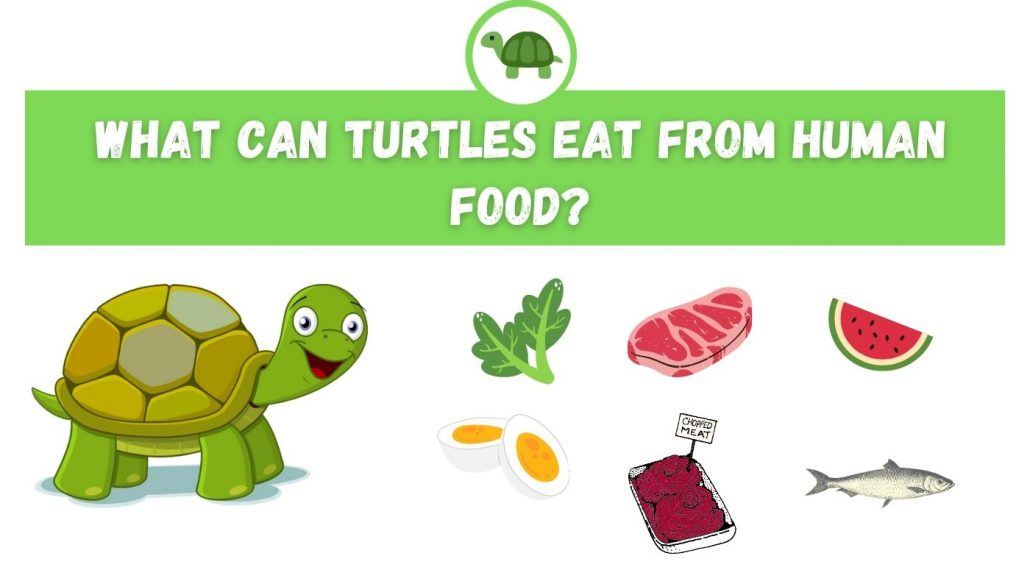In this article, you will learn about the benefits of providing a properly balanced diet for your baby turtles. It is important to understand that the food you feed them plays a crucial role in their overall health and growth. By ensuring they have a well-balanced diet, you can help them develop strong shells, improve their immune system, and promote proper growth.
One of the main benefits of a properly balanced diet for baby turtles is the development of strong shells. Calcium, which can be found in certain foods, is essential for the growth and strength of their shells. By including calcium-rich foods such as calcium-fortified pellets or leafy greens in their diet, you can help prevent their shells from becoming weak or deformed. Additionally, a balanced diet ensures that they receive all the necessary nutrients, vitamins, and minerals that contribute to their overall well-being and vitality. By providing them with a varied diet that includes both animal and plant-based foods, you can boost their immune systems, making them less susceptible to diseases and infections.
Understanding Baby Turtles’ Dietary Needs
The Importance of Proper Nutrition for Baby Turtles
When it comes to the health and well-being of baby turtles, a properly balanced diet is of utmost importance. Just like any other living creature, baby turtles require specific nutrients to support their growth and development. Whether you have herbivorous or carnivorous species of baby turtles, understanding their dietary needs is crucial for their overall health and longevity.
Differentiating Between Herbivorous and Carnivorous Species
Before diving into the specific nutritional requirements, it is essential to differentiate between herbivorous and carnivorous species of baby turtles. Herbivorous turtles primarily feed on plant matter such as vegetables, fruits, and leafy greens. On the other hand, carnivorous turtles consume a diet rich in insects, worms, small fish, and other protein sources.
By identifying the species you have, you can tailor their diet accordingly and ensure they receive the appropriate nutrients for their specific needs.
Understanding the Specific Nutritional Requirements of Baby Turtles
To provide a properly balanced diet for baby turtles, you must understand their specific nutritional requirements. Although the exact needs may vary between species, some essential nutrients are universally vital for baby turtles’ health and well-being.
Essential Nutrients for Baby Turtles
Protein: Building Blocks for Growth
Protein is one of the most critical nutrients for baby turtles, as it serves as the building blocks for growth and development. For carnivorous turtles, protein sources like insects, worms, and small fish are essential to meet their dietary needs. Herbivorous turtles, on the other hand, require plant-based proteins from sources like leafy greens and vegetables.
Ensuring an adequate protein intake helps promote healthy muscle development and overall growth in baby turtles.
Calcium and Vitamin D: Vital for Shell Development
Calcium and vitamin D play a crucial role in the development of baby turtles’ shells. Calcium is necessary for strong and healthy shells, while vitamin D aids in the absorption of calcium from their diet. Without these essential nutrients, baby turtles may develop shell deformities and other health issues.
For herbivorous turtles, calcium can be obtained from calcium-rich vegetables like kale, collard greens, and mustard greens. Carnivorous turtles, on the other hand, acquire calcium from the bones and shells of the prey they consume. Vitamin D can be obtained through exposure to natural sunlight or through proper UVB lighting in their habitat.
Vitamins and Minerals: Supporting Overall Health
In addition to protein and calcium, baby turtles require a variety of vitamins and minerals to support their overall health. These include vitamins A, B, C, and E, as well as minerals like iron, zinc, and magnesium.
Vitamins and minerals are crucial for many bodily functions, including energy production, immunity, and proper organ function. A varied diet that includes a mix of vegetables, fruits, and other nutrient-rich foods is necessary to provide baby turtles with these essential micronutrients.
Fiber: Promoting Proper Digestion
Fiber is another vital component of a baby turtle’s diet, regardless of whether they are herbivorous or carnivorous. Fiber promotes proper digestion and helps prevent digestive issues like constipation. For herbivorous turtles, leafy greens and vegetables are excellent sources of dietary fiber. Carnivorous turtles can benefit from small amounts of fiber found in the exoskeletons of their prey.
Including fiber-rich foods in a baby turtle’s diet helps maintain a healthy digestive system, ensuring proper nutrient absorption and waste elimination.
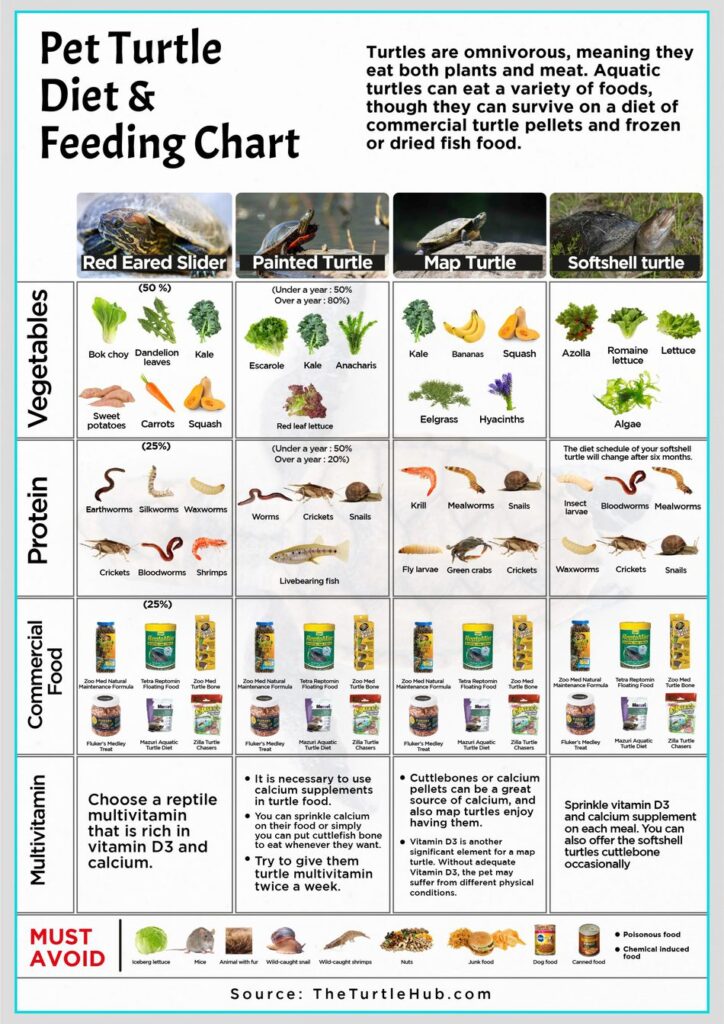
Best Food Options for Baby Turtles
Commercial Turtle Food: A Convenient and Nutritious Choice
Commercial turtle food is a convenient option for providing a well-rounded and balanced diet to baby turtles. These specially formulated turtle pellets contain a mix of essential nutrients, including protein, calcium, vitamins, and minerals. They are available for both herbivorous and carnivorous species, making it easy to meet their specific dietary needs.
When choosing commercial turtle food, ensure that it is of high quality and suitable for the age and species of your baby turtle. Consult with a reptile veterinarian or knowledgeable pet store employee to find the best brand and type of commercial food for your turtle.
The Importance of Incorporating Fresh Leafy Greens
For herbivorous baby turtles, fresh leafy greens should form a significant part of their diet. Leafy greens such as kale, collard greens, and mustard greens are rich in essential nutrients like calcium, vitamins A and C, and fiber. These vegetables provide a natural and nutritious food source for herbivorous turtles, mimicking their diet in the wild.
It is important to ensure that the leafy greens are washed thoroughly to remove any pesticides or contaminants before feeding them to your baby turtles. Additionally, rotating the types of leafy greens offered can provide a wider range of nutrients and prevent boredom.
Supplementing with Insects and Protein-Rich Foods
While herbivorous turtles primarily consume plant-based foods, it is beneficial to supplement their diet with small amounts of insects and protein-rich foods. This helps provide additional essential nutrients like protein and certain vitamins that may be lacking in a solely plant-based diet.
Baby turtles can be offered small quantities of insects like crickets, mealworms, and earthworms. Protein-rich foods such as boiled eggs, shrimp, and fish can also be included in their diet, ensuring a well-rounded nutrient intake.
Feeding Schedule for Baby Turtles
Establishing a Regular Feeding Routine
Establishing a regular feeding routine is essential for baby turtles. Consistency in feeding times helps regulate their digestion and prevents overfeeding or underfeeding. Aim for two to three small meals per day for baby turtles, divided into appropriate portion sizes.
Choose specific times of the day for feeding and stick to the schedule as closely as possible. This helps create a sense of routine for your baby turtle and ensures they receive the necessary nutrients at regular intervals.
Determining the Appropriate Feeding Frequency
The frequency of feeding baby turtles depends on their age and species. Younger turtles may require more frequent feedings, as they have higher metabolisms and faster growth rates. As they mature, the feeding frequency can be gradually reduced.
It is important to monitor your baby turtle’s weight and growth to determine the appropriate feeding frequency. If they are consistently gaining weight and growing at a healthy rate, the feeding frequency is likely adequate. Consult with a reptile veterinarian for specific feeding guidelines based on your baby turtle’s age and species.
Monitoring the Quantity of Food Consumed
While it is important to provide a varied and nutritious diet for baby turtles, it is equally important to monitor the quantity of food they consume. Overfeeding can lead to obesity and other health issues, while underfeeding can result in stunted growth and malnutrition.
Pay attention to your baby turtle’s appetite and behavior during feeding. Observe if they are eating all the food provided or if there is any food left uneaten. Adjust the portion sizes accordingly to ensure they are receiving an appropriate amount of food.
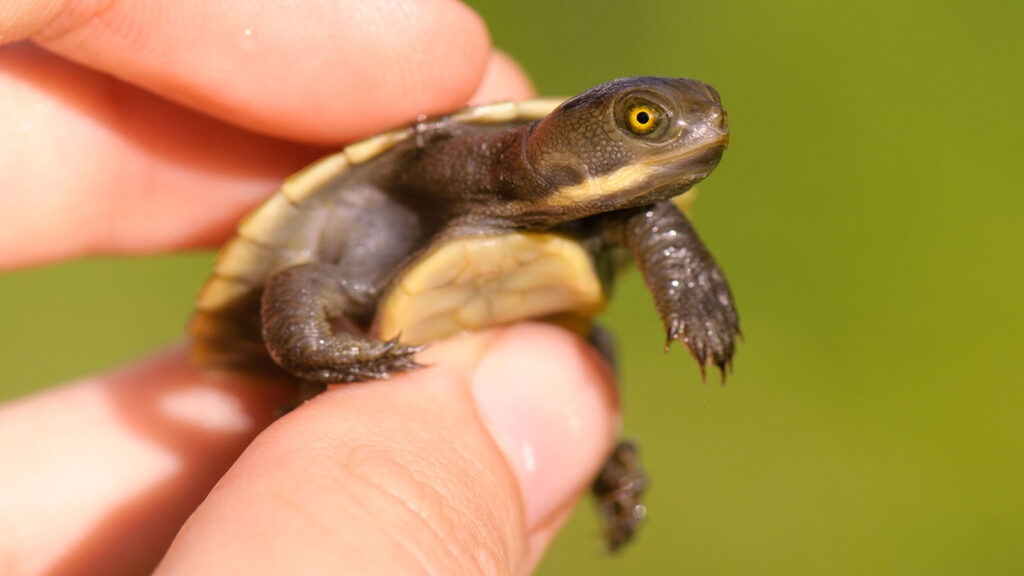
Feeding Techniques for Baby Turtles
Offering Food in a Separate Container to Maintain Cleanliness
To maintain cleanliness and prevent contamination, it is recommended to offer food to baby turtles in a separate container. This allows you to easily remove any uneaten food and prevents the water in their habitat from becoming dirty.
Use a shallow dish or container to hold the food. For herbivorous turtles, place fresh leafy greens or vegetables in the dish. For carnivorous turtles, offer insects or small pieces of protein-rich food.
Ensuring Proper Food Size for Easy Consumption
Baby turtles have small mouths and may have difficulty consuming large pieces of food. To ensure easy consumption, it is important to provide appropriately sized food. This may involve cutting vegetables and leafy greens into smaller, bite-sized pieces or offering smaller insects.
Avoid offering food that is too large or difficult for your baby turtle to consume, as this can lead to choking or digestive issues. If in doubt, consult with a reptile veterinarian for guidance on appropriate food sizes for your baby turtle.
Varying the Feeding Methods to Stimulate Natural Behaviors
In their natural habitat, baby turtles engage in various feeding methods depending on their species. Mimicking these natural behaviors can help stimulate their instincts and provide enrichment during feeding.
For herbivorous turtles, offering food that requires tearing or biting can mimic their natural foraging behaviors. Placing food in different locations within their habitat or using feeding puzzles can encourage them to explore and engage in natural behaviors.
For carnivorous turtles, hiding food or using live prey (with caution) can simulate the hunting and stalking behaviors they would engage in in the wild. However, it is important to minimize the use of live prey to prevent accidents or injuries.
Potential Risks and Hazards in Baby Turtles’ Diet
Avoiding Feeding Exclusively on Commercial Turtle Pellets
While commercial turtle pellets are a convenient and nutritious option, it is important not to rely solely on them for a baby turtle’s diet. Including fresh leafy greens, vegetables, and other natural food sources is crucial for providing a varied and balanced diet.
Feeding exclusively on commercial turtle pellets may not provide all the necessary nutrients and can lead to deficiencies. Supplementing with fresh foods helps ensure a more well-rounded diet and supports optimal health in baby turtles.
Recognizing Toxic Plants and Foods to be Avoided
Certain plants and foods can be toxic or harmful to baby turtles. It is important to recognize and avoid these to prevent health issues or poisoning. Some common toxic plants for turtles include rhubarb leaves, avocado, and daffodils.
Additionally, avoid offering foods that have been treated with pesticides or contain preservatives or additives. Opt for organic and natural food sources whenever possible to minimize the risk of exposing your baby turtles to harmful substances.
Minimizing the Use of Live Prey to Prevent Accidents
While live prey can be stimulating for carnivorous baby turtles, it is important to use caution when incorporating them into their diet. Live prey can bite or injure baby turtles, especially if they are unable to defend themselves adequately.
If using live prey, ensure that it is an appropriate size for your baby turtle and monitor the feeding process closely. Remove any uneaten prey to prevent it from causing harm or stress to your baby turtle.
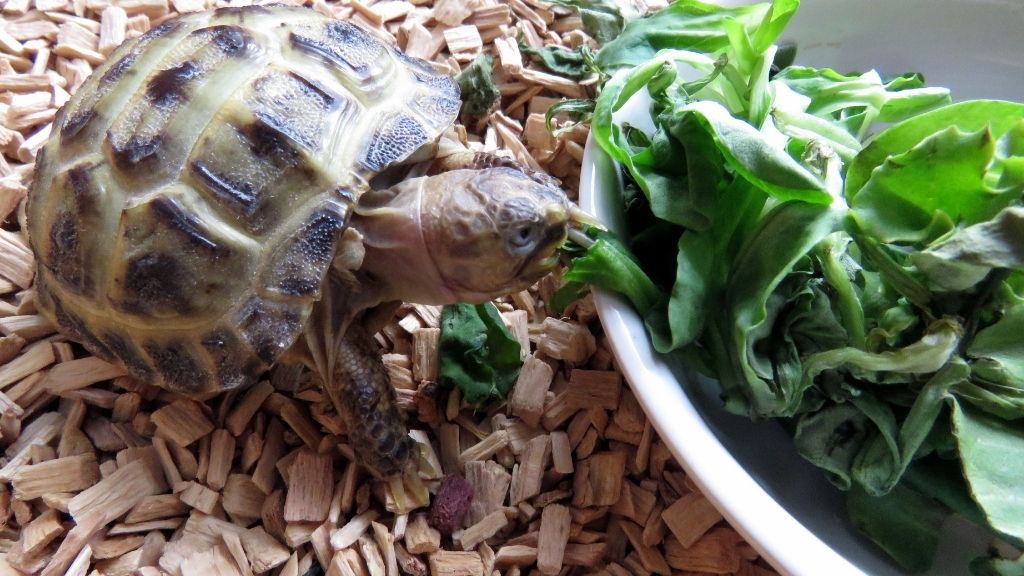
Signs of a Properly Balanced Diet in Baby Turtles
Healthy Shell Growth and Intact Marginal Scutes
A properly balanced diet contributes to healthy shell growth in baby turtles. The shell should be smooth, symmetrical, and free from any deformities or abnormalities. Regularly inspect your baby turtle’s shell and ensure that the marginal scutes, which are the outer edges of the shell, are intact and not chipped or damaged.
Any signs of shell deformities or issues should be addressed promptly by consulting with a reptile veterinarian.
Regular and Solid Waste Elimination
A properly balanced diet ensures regular and solid waste elimination in baby turtles. Their waste should have a firm consistency and be of an appropriate size for their species. Soft or runny feces can indicate digestive issues or an improper diet.
If you notice any abnormalities in your baby turtle’s waste, it is important to assess their diet and make any necessary adjustments to promote proper digestion and waste elimination.
Active and Energetic Behavior
A properly balanced diet supports overall health and energy in baby turtles. They should be active, alert, and display natural behaviors relevant to their species. Lethargy, lack of appetite, or unusual behavior can indicate underlying health issues or an inadequate diet.
Regularly observe and interact with your baby turtles to ensure they are exhibiting normal behavior patterns. Consult with a reptile veterinarian if you have any concerns about their activity levels or behavior.
Common Dietary Issues in Baby Turtles
Shell Deformities Due to Calcium Deficiency
One of the most common dietary issues in baby turtles is shell deformities caused by calcium deficiency. Insufficient calcium intake can lead to soft shells, pyramiding (the shell growing in upward bumpy patterns), and other shell abnormalities.
To prevent calcium deficiency, ensure that your baby turtle’s diet includes calcium-rich foods and that they have access to proper UVB lighting for vitamin D synthesis. Regularly monitor their shell growth and consult with a reptile veterinarian if you notice any abnormalities.
Digestive Problems Caused by Inadequate Fiber Intake
Inadequate fiber intake can lead to digestive problems in baby turtles, including constipation and impaction. Fiber is essential for maintaining proper digestive function and preventing these issues.
Ensure that your baby turtle’s diet includes fibrous foods like leafy greens or sources of fiber from their prey for carnivorous turtles. If your baby turtle experiences recurring digestive problems, consult with a reptile veterinarian for dietary advice and potential medical intervention.
Vitamin Deficiencies Leading to Poor Growth
Vitamin deficiencies can significantly impact a baby turtle’s growth and overall health. Inadequate intake of vitamins A, B, C, and E can lead to poor growth rates, weakened immune systems, and other health issues.
Providing a varied and nutrient-rich diet, including a mix of vegetables, fruits, and other vitamin-rich foods, helps prevent vitamin deficiencies. Regularly assess your baby turtle’s growth and consult with a reptile veterinarian if you notice any stunted growth or signs of vitamin deficiencies.
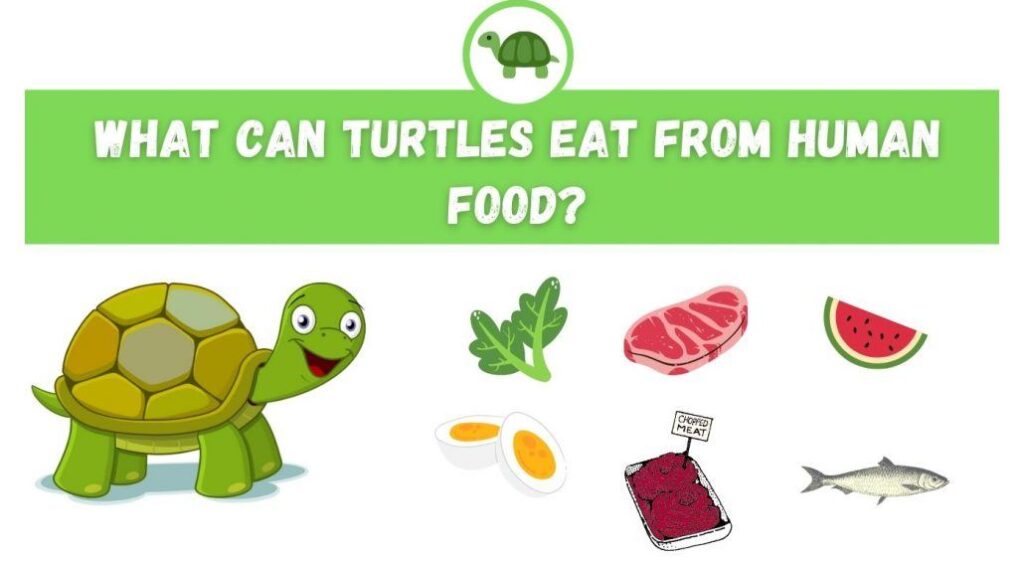
Supplementation and Veterinary Care
Consulting a Reptile Veterinarian for Dietary Advice
For optimal nutrition and health, it is highly recommended to consult with a reptile veterinarian for specific dietary advice for your baby turtles. Reptile veterinarians have specialized knowledge and experience in caring for turtles and can provide tailored guidance based on your baby turtles’ species, age, and individual needs.
They can assess your baby turtles’ diet, make necessary adjustments, and recommend supplements if required to ensure they receive all the essential nutrients for their growth and development.
Supplementing with Calcium and Vitamin D3
Supplementation with calcium and vitamin D3 may be necessary for some baby turtles, especially if their diet does not naturally provide adequate amounts of these nutrients. Reptile-specific calcium and vitamin D3 supplements can be sprinkled on their food or added to their habitat.
Consult with a reptile veterinarian to determine if your baby turtles require supplementation and to receive specific recommendations on dosage and frequency.
Special Considerations for Specific Turtle Species
Different species of baby turtles may have unique dietary requirements or sensitivities. Some species may require additional supplements, while others may need specific food sources.
Research or consult with a reptile veterinarian to understand the specific needs of your baby turtles’ species. Ensure that their diet is tailored to meet those specific requirements for optimal health and well-being.
Transitioning to an Adult Turtle Diet
Gradual Introduction of Adult Turtle Food
As baby turtles grow and mature, their dietary needs evolve. Eventually, they will need to transition to an adult turtle diet. This transition should be done gradually to prevent digestive issues or stress.
Introduce adult turtle food slowly by incorporating small amounts into their current diet. Gradually increase the proportion of adult food while decreasing the baby food until they are fully transitioned to the adult diet.
Adjusting Nutritional Requirements for Growth and Reproduction
As baby turtles mature into adults, their nutritional requirements may change due to growth and, in the case of females, reproduction. Monitor their weight and growth, adjusting their diet as necessary to support their changing needs.
For females preparing to reproduce, providing additional calcium-rich foods and supplements may be necessary to support egg production and shell development.
Monitoring Weight and Size for Proper Development
Weight and size are important indicators of proper development in baby turtles. Regularly monitor their weight and size, comparing them to species-specific growth charts or consulting with a reptile veterinarian.
If you notice any significant deviations from the expected growth patterns or if your baby turtles are consistently under or overweight, adjust their diet and consult with a reptile veterinarian for guidance.
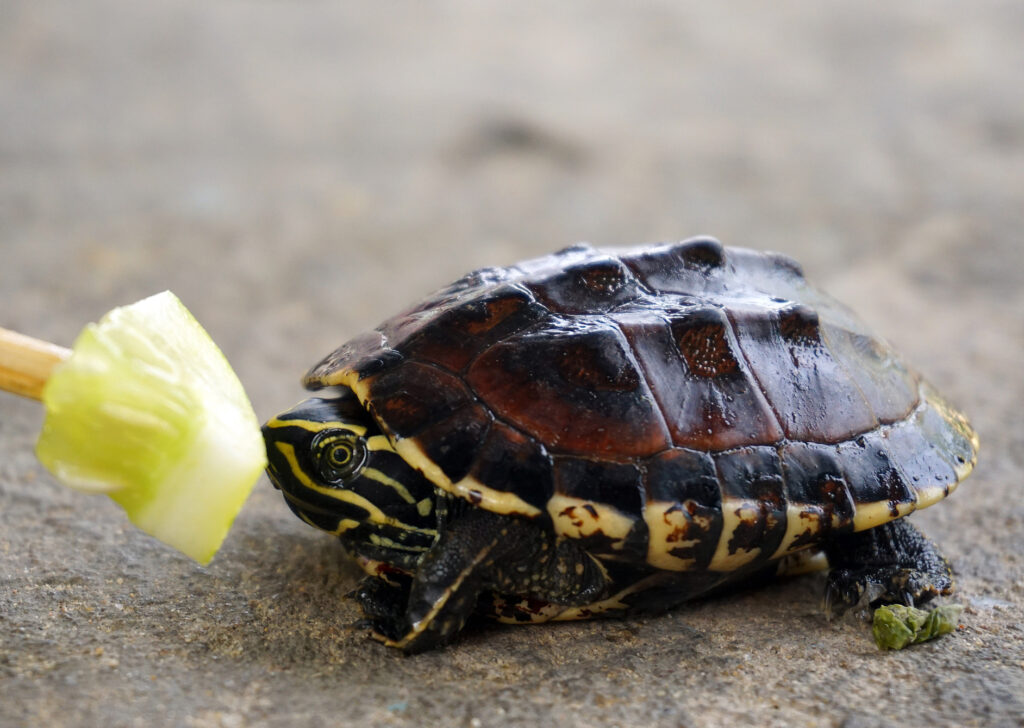
Importance of Proper Hydration
Providing Access to Clean and Fresh Water
Proper hydration is crucial for baby turtles’ health and well-being. Ensure they have access to clean and fresh water at all times. Water bowls should be large enough for them to soak and swim, and the water should be changed regularly to prevent contamination.
Monitor their water intake and observe if they are drinking regularly. Dehydration can lead to health issues, so it is important to encourage and support proper hydration in baby turtles.
Avoiding Overhydration and Drowning Risks
While it is important to provide access to water, it is equally important to avoid overhydration and drowning risks. Baby turtles should be supervised during water activities, especially if they are too young or inexperienced swimmers.
Additionally, be mindful of the depth of the water in their habitat, ensuring it is appropriate for their size and species. Provide accessible land areas or basking spots where they can rest and dry off after swimming.
Hydration Techniques for Semi-Aquatic and Aquatic Species
Semi-aquatic and aquatic species of baby turtles have different hydration needs compared to fully terrestrial species. These turtles spend a significant amount of time in the water, so their hydration requirements may be different.
For semi-aquatic and aquatic baby turtles, ensure they have ample swimming space and access to both land and water. Monitor their water quality and cleanliness regularly to maintain optimal hydration.
The Role of Sunlight in Turtle Nutrition
Understanding Turtles’ Need for UVB Exposure
Sunlight plays a crucial role in turtle nutrition, specifically their need for UVB exposure. UVB rays stimulate the synthesis of vitamin D3 in their skin, which aids in calcium absorption and overall health.
Allowing baby turtles to receive natural sunlight is ideal. However, if they are housed in an indoor habitat, providing UVB lighting specifically designed for reptiles is essential. These lights emit the necessary UVB rays to support vitamin D3 synthesis.
Creating an Adequate Basking Area for Effective Absorption
In addition to UVB lighting, creating an adequate basking area is essential for baby turtles. Basking allows them to absorb the UVB rays and regulate their body temperature. Basking areas should be positioned near the UVB lighting source and provide a temperature gradient to accommodate the turtle’s specific requirements.
Ensure that the basking area is easily accessible and large enough for your baby turtles to fully stretch out and dry off. Regularly monitor the temperature and adjust the lighting and heating elements as needed.
UVB Lighting Options for Indoor Turtle Habitats
If natural sunlight is not readily available, UVB lighting options specifically designed for reptiles are necessary for indoor turtle habitats. There are various UVB lighting options available, including UVB bulbs and fluorescent light fixtures.
Choose a UVB lighting source appropriate for your baby turtles’ habitat size and species. Follow the manufacturer’s guidelines for the recommended distance from the lighting to ensure optimal UVB exposure for your baby turtles.
The Impact of Temperature on Baby Turtles’ Diet
Temperature Regulation for Digestive Function
Temperature plays a critical role in the digestion of baby turtles. Their digestive function is regulated by the ambient temperature of their habitat. Without the appropriate temperature range, their digestion can be compromised, leading to various digestive issues.
Maintaining a suitable temperature gradient in the habitat allows baby turtles to properly digest their food and absorb nutrients. Consult with a reptile veterinarian or research the specific temperature requirements for your baby turtles’ species.
Thermoregulation Techniques for Optimal Feeding
In the wild, baby turtles engage in thermoregulation behaviors to regulate their body temperature and support optimal feeding. When providing a habitat for baby turtles, it is important to create a temperature gradient that allows them to engage in these behaviors.
Use heating elements such as heat lamps or heating pads to create a warm basking area and a cooler area in the habitat. This allows baby turtles to move between different temperature zones based on their needs, facilitating proper digestion and feeding behaviors.
Avoiding Feeding during Hibernation or Brumation Periods
Certain turtle species undergo hibernation or brumation periods, during which their metabolic rate slows down significantly. During these periods, it is important to avoid feeding baby turtles, as their digestive system may not be active.
Research or consult with a reptile veterinarian to determine if your baby turtles’ species undergoes hibernation or brumation and what their specific requirements are during these periods.
Conclusion
Ensuring a properly balanced diet for baby turtles is vital for their overall health and well-being. By understanding their specific nutritional requirements, providing a varied and nutrient-rich diet, and following appropriate feeding techniques, you can support their growth and development.
Consult with a reptile veterinarian for tailored dietary guidelines based on your baby turtles’ species, age, and individual needs. Regularly monitor their growth, behavior, and overall health to ensure they are thriving on a properly balanced diet.
By maintaining a healthy and well-nourished baby turtle, you are setting them up for a long and vibrant life as they grow into adult turtles.
